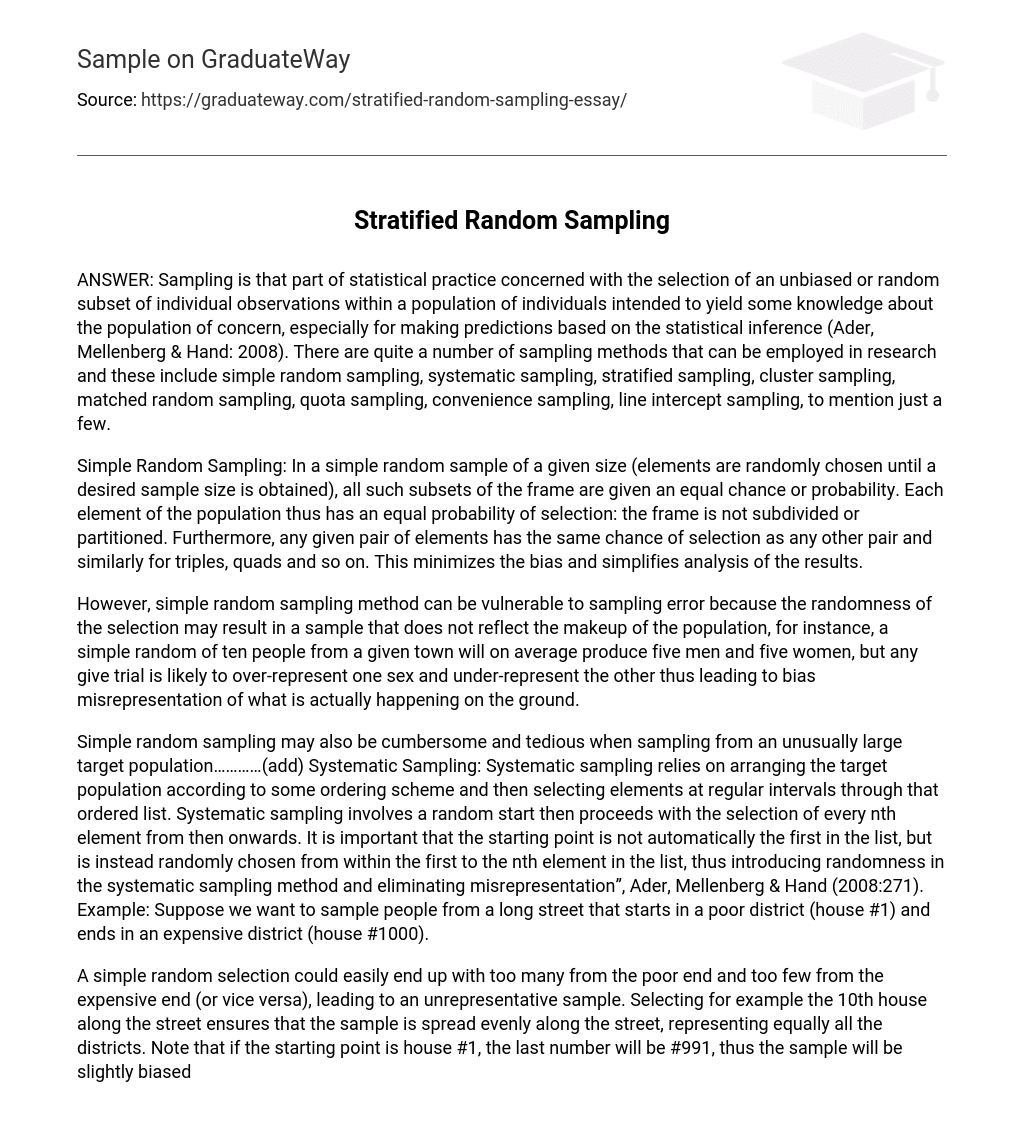ANSWER: Sampling is that part of statistical practice concerned with the selection of an unbiased or random subset of individual observations within a population of individuals intended to yield some knowledge about the population of concern, especially for making predictions based on the statistical inference (Ader, Mellenberg & Hand: 2008). There are quite a number of sampling methods that can be employed in research and these include simple random sampling, systematic sampling, stratified sampling, cluster sampling, matched random sampling, quota sampling, convenience sampling, line intercept sampling, to mention just a few.
Simple Random Sampling: In a simple random sample of a given size (elements are randomly chosen until a desired sample size is obtained), all such subsets of the frame are given an equal chance or probability. Each element of the population thus has an equal probability of selection: the frame is not subdivided or partitioned. Furthermore, any given pair of elements has the same chance of selection as any other pair and similarly for triples, quads and so on. This minimizes the bias and simplifies analysis of the results.
However, simple random sampling method can be vulnerable to sampling error because the randomness of the selection may result in a sample that does not reflect the makeup of the population, for instance, a simple random of ten people from a given town will on average produce five men and five women, but any give trial is likely to over-represent one sex and under-represent the other thus leading to bias misrepresentation of what is actually happening on the ground.
Simple random sampling may also be cumbersome and tedious when sampling from an unusually large target population…………(add) Systematic Sampling: Systematic sampling relies on arranging the target population according to some ordering scheme and then selecting elements at regular intervals through that ordered list. Systematic sampling involves a random start then proceeds with the selection of every nth element from then onwards. It is important that the starting point is not automatically the first in the list, but is instead randomly chosen from within the first to the nth element in the list, thus introducing randomness in the systematic sampling method and eliminating misrepresentation”, Ader, Mellenberg & Hand (2008:271). Example: Suppose we want to sample people from a long street that starts in a poor district (house #1) and ends in an expensive district (house #1000).
A simple random selection could easily end up with too many from the poor end and too few from the expensive end (or vice versa), leading to an unrepresentative sample. Selecting for example the 10th house along the street ensures that the sample is spread evenly along the street, representing equally all the districts. Note that if the starting point is house #1, the last number will be #991, thus the sample will be slightly biased to the poor end; by randomly selecting the start between #1 and #10, this bias is eliminated. Systematic sampling is especially vulnerable to periodicities in the list/sample.
If periodicity exists and the period is a multiple or factor of the interval used, the sample is likely to be unrepresentative of the overall population. Another drawback of systematic sampling is that even in scenarios where it is more accurate, its theoretical properties make it difficult to quantify that accuracy (in the example cited, potential sampling error is due to variation between neighboring houses but because this method never selects neighboring houses, the sample will not give any information on that variation)……. [add]
Stratified Sampling: If a sample is to be selected in a population where there is no distinct homogeneity, but embraces a number of distinct categories, the frame can be organized by these categories into separate ‘strata’. Each stratum is then sampled as an independent sub-population, out of which individual elements can be randomly selected (Pedhazur & Schmelkin: 1991). This whole process is known as Stratified random sampling. Thus, stratified sampling brings about the aspect of proportionality in the sense that the size of each tratum will determine the number of elements to be sampled therein (each stratum is proportional to the group’s size in the population). There are several benefits to stratified sampling; first, dividing the population into distinct, independent strata can enable researchers to draw inferences and information about specific subgroups that may be lost in a more generalized random sample. Second, using a stratified sampling method can also lead to more efficient statistical estimates, provided the strata within the population are selected based upon relevance to the criterion in question, instead of availability of samples.
Third, since each stratum is treated as an independent population, different sampling can be applied at different strata, enabling researchers to use the approach best suited for each identified subgroup within the population. There are, however, some disadvantages to using stratified sampling. Identifying strata and implementing such an approach can increase the complexity of sample selection as well as leading to complexity of population estimates.
Another drawback may be that when examining multiple criteria, stratifying variables may be related to some but not others, thus complicating the design and reducing the utility of the strata. Also, in some cases with a large number of strata, stratified sampling may require a larger sample than would other methods. Stratified sampling is not useful where there are no homogenous groups and thus is not applicable in these cases and also can be expensive to implement. Cluster Sampling: In cluster sampling, the population is divided into ‘natural’ groups (called clusters)





